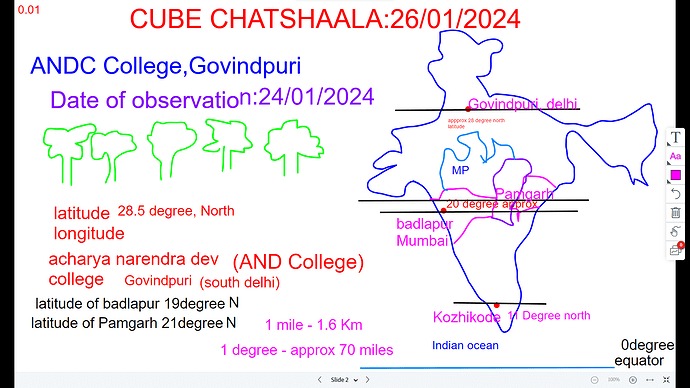In a recent comparative discussion on mango mapping across India, our exploration led us to an intriguing examination of latitudes and their profound impact on mango cultivation. The causerie has revelations and discussions that unfolded during our comparative study of mango-growing regions, including Archaya Narendra Dev College (ANDC) (located in Govindpuri, Delhi), Kozhikode in Kerala, and Badlapur near Mumbai.
With a fundamental understanding of latitudes. Latitudes are measured from the equator, which serves as the reference point at 0 degrees. Astonishingly, the equator runs through the Indian Ocean, providing a unique perspective on how latitudes influence the climate and growing conditions across the country.
A Comparative Latitude Analysis on the latitudinal differences between AND College in Delhi (28.5 degrees north), Badlapur near Mumbai (19 degrees north), and Kozhikode (11 degrees north). These variations, though seemingly small, play a pivotal role in the flowering and fruiting patterns of mango trees.
TINKE (This I never knew earlier) moments occurred when we discovered that Maharashtra and Chhattisgarh share a border. Specifically, Maharashtra shares its eastern border with Chhattisgarh, understanding the twists and turns of how places are arranged on a map that were previously unknown to @Theertha @Enas and some other participants. Other TINKE moments was the realization that 1 degree of latitude is approximately equivalent to 70 miles. This understanding showed the significance of seemingly minor variations in latitudes and their impact on the agricultural landscape. A key highlight of the causerie was the clarification provided by Vijaya Tilak, resolving misconceptions about latitude and longitude and nuanced differences that a 1-degree change in latitude can bring.
The Two-Degree Phenomenon
A revelation that emerged during the discussion was the two-degree difference in latitude between Badlapur, Maharashtra (19 degrees north), and Pamgarh, Chhattisgarh (21 degrees north). This seemingly minor difference carries significant implications for mango cultivation, highlighting the climatic variations that influence the growth and yield of mango.
The causerie highlights the importance of understanding geographical coordinates in mango mapping, connecting these insights to biogeography by demonstrating how subtle variations in latitude can significantly influence the phenology of mango trees across diverse regions in India.
